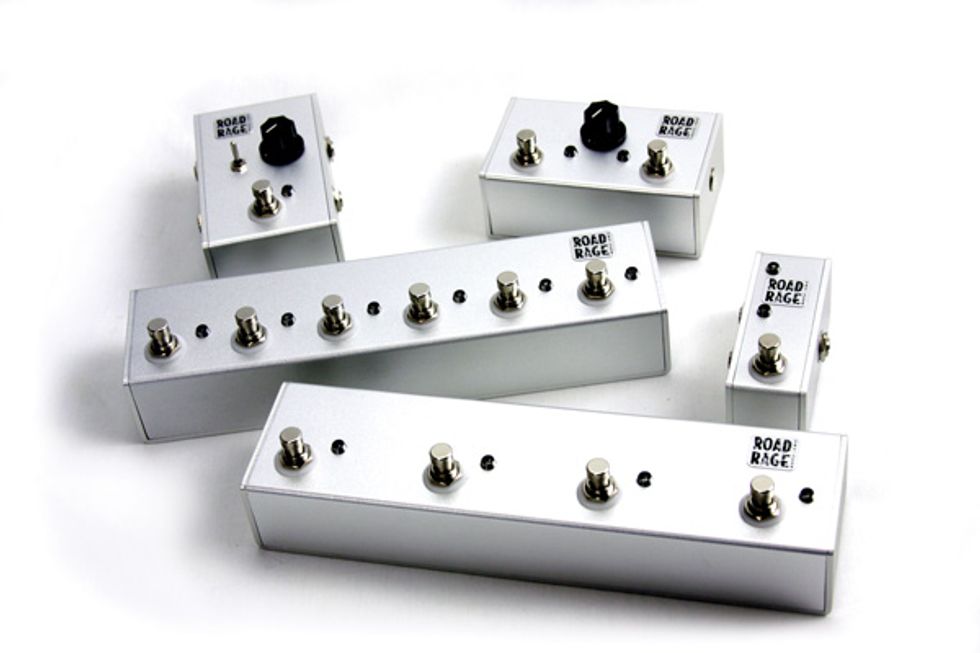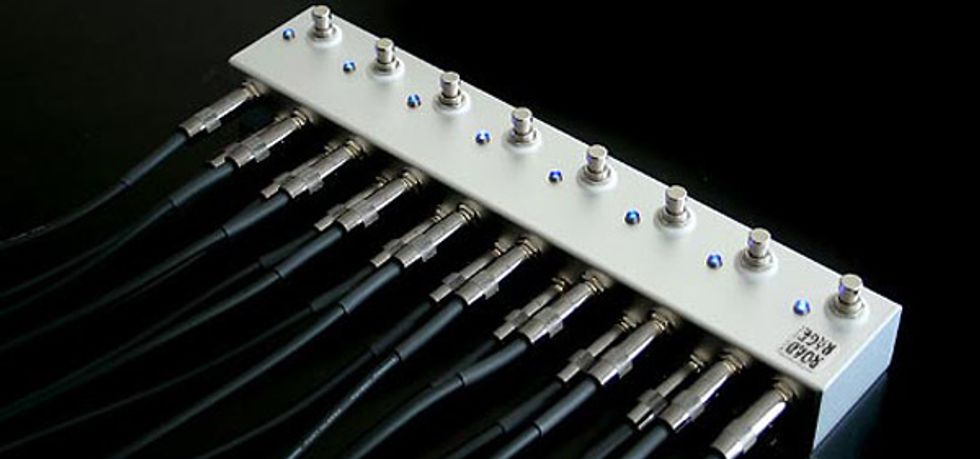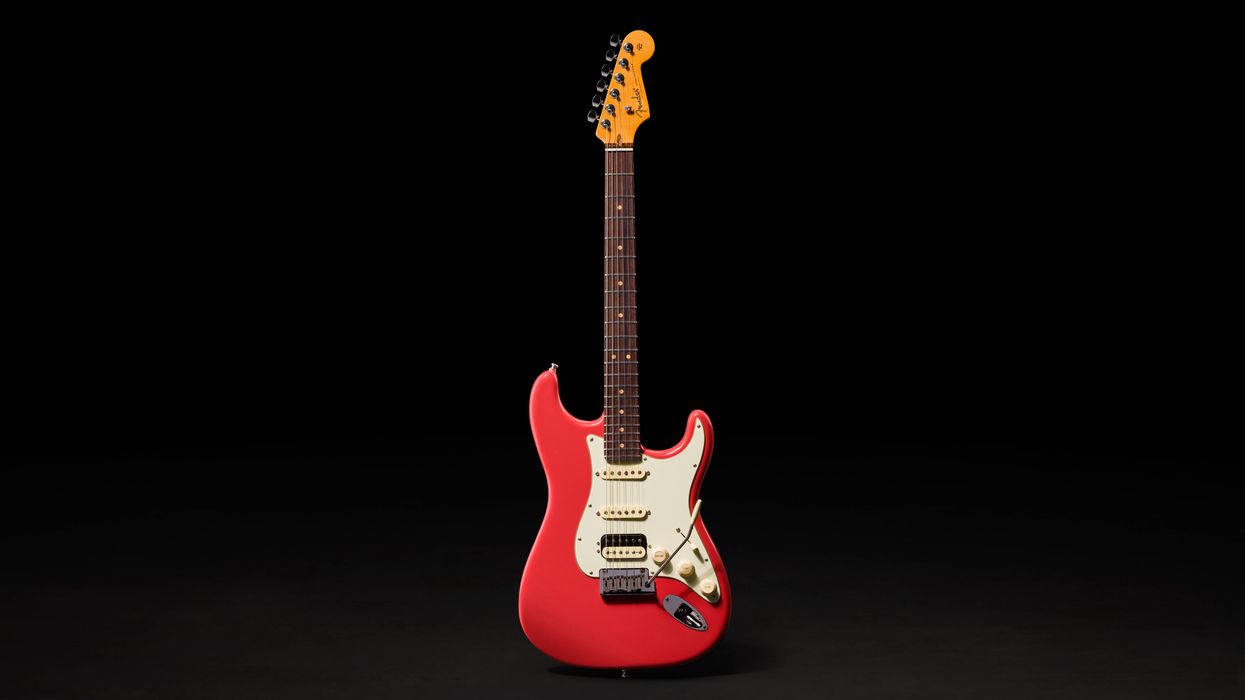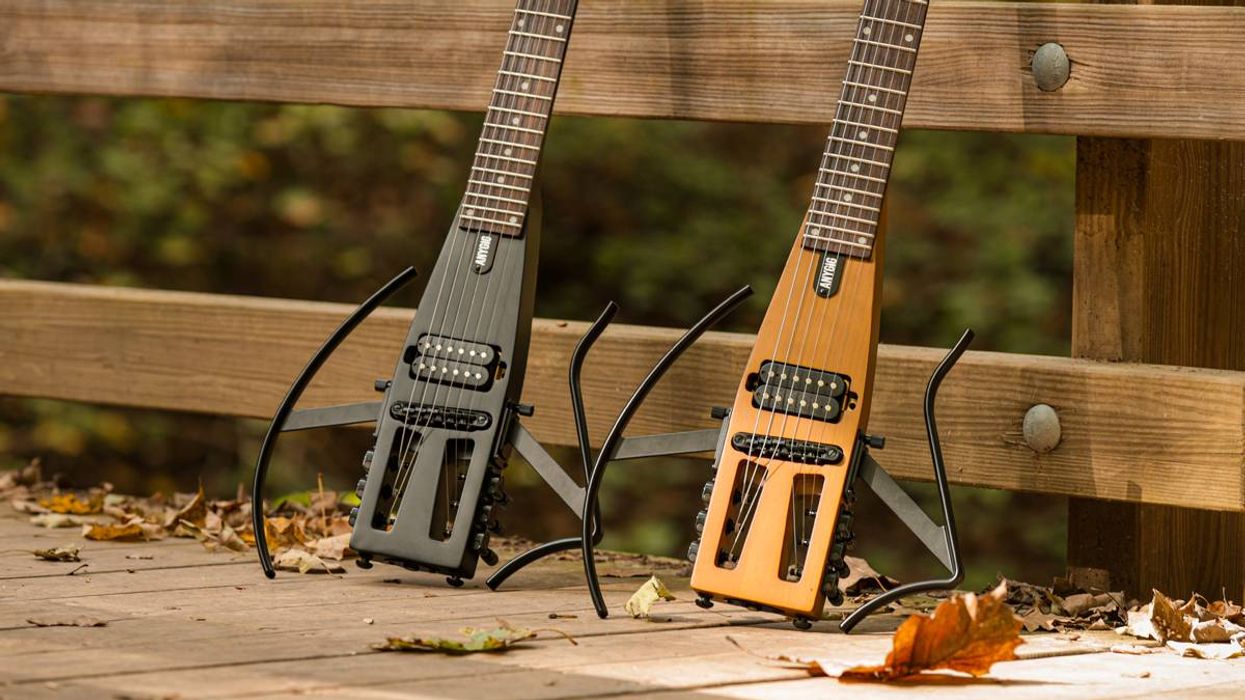My buddy Tommy Bruner walked up to me in a local music store a few weeks ago, utterly stoked. He started rattling on about something called a Road Rage TBEL, and I smiled and nodded my head and told him that was awesome, and went back to whining about how they’d sold all the nice acoustic guitars.
But somehow, I managed to retain enough of the conversation to look up Road Rage Pro Gear online, and ask them to send some stuff for us to check out. You may have seen some references to Road Rage in recent reviews and features in PG, because I have been finding all sorts of uses for it.
I decided to get Tom involved in this review, as he, being an electric player, uses this gear in a whole different way than I do, being an acoustic player. In addition to a straight-up review of the thing itself, we’ll talk about how we each use it in our stage rigs. Tommy’s pedalboard is so darn pretty I talked him into a video demo, too.

What is it?
For those unfamiliar with the acronym, TBEL stands for True-Bypass Effect Looper. Running your effects through a TBEL prevents the signal degradation you get when you run your effects one-into-another in a chain (some newer effects do have true-bypass circuitry, but they’re few and far between). This “chain of tools” can suck volume and tone, and add non-useful noise to the tone you have worked so hard to master.
Additionally, for those who use multiple guitars and have different effects for each guitar, it’s awesome to have a box that lets you use a single amp input for every guitar and control which effect you get through the TBEL switches. And to state the obvious, it sure is nice to have something so clean and organized as a single strip of switches instead of a more unwieldy or confusing array.
It’s Shiny.
Canadian-made Road Rage Pro Gear comes minimally packaged in simple white branded boxes. The pedals are swaddled in bubble wrap and packed in with instructions and a “jack map.” The only quibble we had with the pedals is that there are no send/return labels on the jacks. This is only a quibble, because once you plug everything in and put it into your pedal board, you don’t have to think about any of that again (unless you are adding or replacing effect pedals). Road Rage makes everything from a single-channel A/B switch to a ten-channel TBEL as regular stock, and will happily make custom loopers with as many channels as you’d like.
It’s got heft, and it’s extremely solid feeling, both big plusses when it’s holding this position in your signal chain; when you rely on it, every gig, to help you get the best tone possible, the last thing you want is a flimsy box that lacks authority. The 3mm thick anodized aluminum chassis is accented by ridiculously bright blue LEDs that you can see under bright stage lights and in full sunlight. The looper requires D/C power for those LEDs, but works perfectly without power, though it is a little disconcerting to “fly blind” (if you’re using a pedalboard, chances are you’re using a multi-pedal power source anyway).
It Sounds Like…
It’s silent. That’s what you want. More importantly, operation is flawless. You stomp on the switch, the light goes on, the effect is there. You stomp again, the light goes off, the effect is gone. You can have as many pedals going at once as you can stand, and it all sounds just like you, effected, with no decrease in volume as you add more pedals.
Because there’s no sound to evaluate, it’s all about function and ease of use. The switches are all in a row, but laid out so you can hit one at a time without “fat footing” another by accident, but at the same time close enough so you can hit two at once if you need, to instantly turn one unit off and another on, or turn two on or off at the same time. It takes a little advance planning to make sure you’ve got what you need all together in a row, but it’s very worth the effort. Tommy says with some relief, “It eliminates the infamous Pedal Dance.”

Setup is easy and intuitive, though choice of patch cable is pretty critical. We needed to do a few “dry fittings” with our pedals and pedalboards to determine what lengths of cable we needed, and the type of jacks that would make layout easy, neat and functional (straight, 90-degree, etc.). Jeff Wesseling, Road Rage founder, custom-built Bruner’s TBEL with the main in and out in a different place at no extra charge, to eliminate almost a foot of patch cable inside his board.
Tommy’s Rig
| Watch Tommy demo his looper: Click to see video full-size. |
Bruner found the biggest difference to be the clarity and presence that the Road Rage brought to his sound, but a really significant added benefit was the ability to design a pedalboard where everything except the looper and the long/short switch for the delay are enclosed in a 3/4" Birch case with a hinged lid. This means they are completely protected from accidental mis-adjustment, careening dancers, light rain and most of the everyday things that can threaten a pedalboard.
Gayla’s Rig
I like to take two guitars with me: one for DADGAD, and one for that funny EADGBE tuning that’s so popular. They are two very different guitars; one is rosewood, one is mahogany. The rosewood guitar is also slightly bigger and deeper than the mahogany guitar, so it’s got a lot of bass response that the smaller, thinner, mahogany guitar does not have. I have a two-channel amp, an L.R. Baggs Core 1 Acoustic Reference Monitor, and because I’m a singer, I use one channel for a vocal mic and the other for guitar. However, I cannot possibly use the same EQ settings for these two guitars, and there’s no compromise that sounds remotely okay, so I’ve been stuck with taking just one guitar and tuning back and forth all night, which works but is a real time suck on stage.
With the Road Rage TBEL I was able to assemble a pedalboard that includes two L.R. Baggs ParAcoustic DI boxes, each dialed in for a specific guitar. For the mahogany guitar, I also add an Aphex Acoustic Xciter pedal, which allows that guitar to sound just as big, though not as bassy, as its big rosewood sister. I set the tone controls on the Core 1 flat, and sculpt the sound with the pedals only. Depending on whether it’s a solo gig or a gig with my trio, I can dial bass in or out during soundcheck with the controls on the Core 1, making it a highly flexible and functional rig for my needs.
Being an acoustic guitarist, many of my pedals are DIs and use phantom power, and that’s the only real frustration I’ve had with this, and I have to say it has been a bit of an adjustment. Some pedals drain their batteries if anything is plugged into the input, even if they’re not active, making a power adapter necessary instead of optional for me. But all things considered, the freedom it offers me to keep my rig small and manageable while adding a second guitar is well worth the frustration.
The Final Mojo
Any piece of gear that is rock-solid and allows a musician to be more efficient and versatile while sounding better is must-have in our book. If it’s shiny and lights up like the bridge of the Enterprise… bonus! Electric and acoustic guitarists very rarely get to use the same piece of gear; our pickups, amps, strings and pedals are completely different, so one single piece of gear that can play such a strong role in both worlds is remarkable indeed.
Buy if...
you want to make life-with-pedals a lot easier, while cleaning up your tone.
Skip if...
dirty pedal noise is part of your signature tone.
Rating...
MSRP (8-channel) $189.99 - Road Rage Pro Gear - roadrageprogear.com |






![Rig Rundown: AFI [2025]](https://www.premierguitar.com/media-library/youtube.jpg?id=62064741&width=1245&height=700&quality=70&coordinates=0%2C0%2C0%2C0)



![Devon Eisenbarger [Katy Perry] Rig Rundown](https://www.premierguitar.com/media-library/youtube.jpg?id=61774583&width=1245&height=700&quality=70&coordinates=0%2C0%2C0%2C0)












































